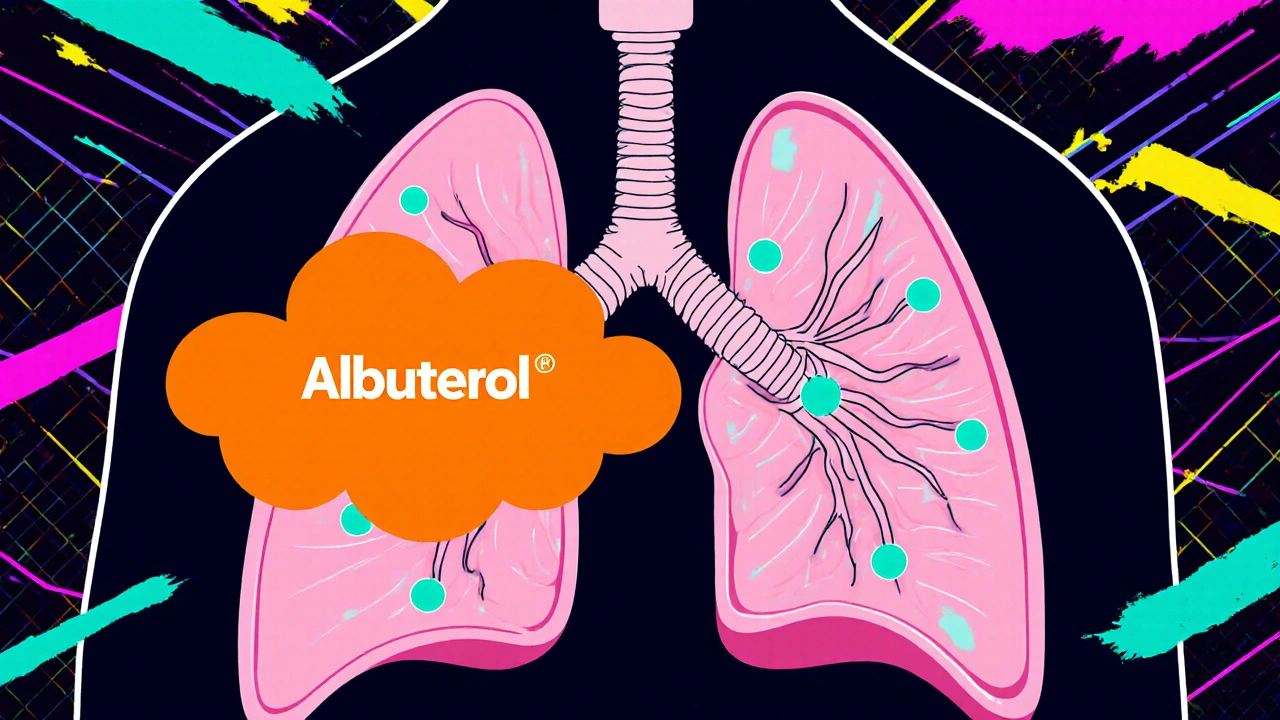If you or someone you love lives with asthma, you’ve probably heard the name Albuterol tossed around during doctor visits. But what makes Albuterol different from the dozens of other pills, inhalers, and nebulizer solutions on the market? Knowing when to reach for Albuterol and when another drug might work better can keep symptoms in check and avoid unnecessary side‑effects.
Key Takeaways
- Albuterol is a short‑acting beta‑agonist (SABA) designed for quick relief of asthma attacks.
- Long‑acting beta‑agonists (LABAs) such as Salmeterol and Formoterol are meant for maintenance, not rescue.
- Inhaled corticosteroids (ICS) like Fluticasone treat underlying inflammation and are the cornerstone of daily control.
- Leukotriene modifiers (e.g., Montelukast) and theophylline offer oral alternatives for specific cases.
- Choosing the right medication depends on symptom pattern, severity, and any co‑existing health issues.
How Albuterol Works
When you inhale Albuterol, the drug binds to beta‑2 receptors on the smooth muscle lining your airways. This binding triggers a cascade that relaxes the muscle, widening the bronchial tubes within minutes. Because it acts fast and its effect lasts about 4-6 hours, Albuterol is classified as a SABA, a short‑acting beta‑agonist used for rescue therapy.
Typical delivery methods include metered‑dose inhalers (MDIs), dry‑powder inhalers (DPIs), and nebulizer solutions. The dosage is tailored to age and severity, but most adults start with 2 puffs (90‑100 µg per puff) as needed, not exceeding 8 puffs in 24 hours.
Main Classes of Asthma Medications
Understanding the landscape of asthma drugs helps you see where Albuterol fits.
- SABA: Fast‑acting relief (Albuterol, Levalbuterol).
- LABA: Long‑acting bronchodilation (Salmeterol, Formoterol). Must be paired with an inhaled corticosteroid.
- ICS: Anti‑inflammatory control (Fluticasone, Budesonide, Mometasone).
- Leukotriene receptor antagonists (Montelukast, Zafirlukast) - oral tablets that block inflammatory mediators.
- Anticholinergics (Ipratropium, Tiotropium) - block acetylcholine, useful for COPD overlap.
- Theophylline - oral methylxanthine that relaxes airway smooth muscle; requires blood‑level monitoring.

Comparing Albuterol to Other Common Options
| Medication | Class | Onset | Duration | Typical Use | Key Side Effects |
|---|---|---|---|---|---|
| Albuterol | SABA | 1‑5 min | 4‑6 hrs | Rescue for acute bronchospasm | Tremor, tachycardia, nervousness |
| Salmeterol | LABA | 15‑30 min | 12 hrs | Maintenance in combination with ICS | Potential for increased asthma‑related death if used alone |
| Fluticasone | ICS | Several hours (anti‑inflammatory) | 24 hrs+ | Daily control of airway inflammation | Oropharyngeal candidiasis, hoarseness |
| Montelukast | Leukotriene antagonist | 2‑4 hrs | 24 hrs | Adjunct for exercise‑induced asthma | Rare neuropsychiatric effects |
| Theophylline | Methylxanthine | 30‑60 min | 6‑12 hrs | Alternative when inhalers aren’t tolerated | Cardiac arrhythmia, seizures at high levels |
When to Reach for Albuterol vs. Other Medications
Think of asthma care as a two‑step system: control (reduce baseline inflammation) and relief (open the airway fast). Albuterol shines in the relief step. Use it whenever you feel:
- Wheezing, coughing, or shortness of breath that isn’t quickly improving.
- Exercise‑induced bronchoconstriction before a workout (pre‑dose 15 minutes prior).
- A sudden exposure to a known trigger (dust, pollen, cold air).
In contrast, medications like Fluticasone or Budesonide are taken daily, regardless of symptoms, to keep the airway lining calm. LABAs such as Salmeterol are added when daily symptoms persist despite low‑ to medium‑dose ICS. They provide smoother breathing throughout the day but never replace a rescue inhaler.
For patients who can’t tolerate inhalers-perhaps due to severe coordination issues-oral options like Montelukast or Theophylline become practical, though they work slower and often need to be paired with an inhaled agent for acute episodes.
Safety, Side Effects, and Interactions
Every asthma drug carries a risk profile. Here’s a quick look at the most common issues.
- Albuterol: Tremor, rapid heartbeat, headache, occasional hypokalemia (low potassium) if over‑used.
- LABAs (Salmeterol, Formoterol): Same heart‑rate effects plus a rare but serious increase in asthma‑related deaths when used without an ICS.
- ICS (Fluticasone, Budesonide): Localized fungal infections in the mouth, hoarseness, rarely adrenal suppression with high doses.
- Montelukast: Mood changes, nightmares, rare suicidal thoughts-monitor patients closely.
- Theophylline: Narrow therapeutic window; high levels cause nausea, arrhythmia, seizures. Requires blood‑level checks.
Drug‑drug interactions matter, too. Albuterol can boost the effect of beta‑blockers (which are usually avoided in asthma patients). Theophylline interacts with many antibiotics (e.g., macrolides) and fluoroquinolones, raising its blood concentration.
Practical Tips for Managing Asthma with Medication
- Keep a rescue inhaler handy. Store it in your bag, car, and at work. Replace it before the expiration date.
- Use a spacer with MDIs. It reduces oropharyngeal deposition and improves lung delivery.
- Rinse your mouth after using an inhaled corticosteroid to prevent thrush.
- Track your symptoms in a diary or app. Patterns help your doctor adjust the control plan.
- Review your action plan each season. Triggers shift, and your medication doses might need tweaking.
- If you need Albuterol more than twice a week, contact your healthcare provider-your baseline therapy likely needs strengthening.
Remember, no single drug works for everyone. A personalized blend of control and rescue meds, plus lifestyle adjustments, gives the best chance of staying symptom‑free.
Frequently Asked Questions
Can I use Albuterol every day?
Using Albuterol daily usually signals that your asthma isn’t well‑controlled. Talk to a doctor about stepping up your maintenance therapy, such as adding an inhaled corticosteroid.
Is a LABA ever safe without an inhaled steroid?
No. Regulatory agencies require LABAs to be paired with an inhaled corticosteroid because using a LABA alone has been linked to severe exacerbations and even death.
What’s the difference between Albuterol and Levalbuterol?
Levalbuterol is the R‑enantiomer of Albuterol. It offers a similar bronchodilating effect with slightly fewer cardiovascular side effects, but it’s more expensive and not always covered by insurance.
Can I use a spacer with a dry‑powder inhaler?
No. Spacers are designed for metered‑dose inhalers. Dry‑powder inhalers rely on your inhalation force to disperse the medication, so a spacer would reduce effectiveness.
Are there natural alternatives to Albuterol?
While breathing exercises and allergen control can reduce reliance on rescue inhalers, they don’t replace Albuterol during an acute attack. Always keep a rescue inhaler as part of your plan.






Brett Witcher
October 24, 2025 AT 19:23The pharmacodynamic profile of albuterol, as a short‑acting β2‑adrenergic agonist, is unequivocally distinct from that of its long‑acting counterparts. Its rapid onset, typically within one to five minutes, predicates its designation as a rescue medication. Conversely, agents such as salmeterol exhibit a delayed onset approximating fifteen minutes, rendering them unsuitable for acute bronchospasm. The duration of clinical effect for albuterol, spanning four to six hours, aligns with the temporal window required to abort episodic exacerbations. Long‑acting β2‑agonists, by contrast, sustain bronchodilation for upwards of twelve hours, a pharmacokinetic attribute advantageous for maintenance therapy. Moreover, the molecular affinity of albuterol for the β2 receptor is characterized by a high turnover rate, facilitating swift dissociation and consequent reversibility. This reversible binding underlies the favorable safety margin observed in intermittent use. Inhaled corticosteroids, exemplified by fluticasone, exert their therapeutic effect via modulation of transcriptional pathways, a mechanism fundamentally disparate from β‑agonism. The anti‑inflammatory cascade invoked by corticosteroids necessitates a latency period of several hours to days before clinical benefit manifests. Consequently, the clinical algorithm mandates the concurrent employment of a rescue SABA and a controller ICS for optimal disease control. The ancillary class of leukotriene receptor antagonists, such as montelukast, offers oral convenience but lacks the immediacy of bronchodilation required in emergent scenarios. Theophylline, an older methylxanthine, presents a narrow therapeutic index, obligating serum level monitoring and exposing patients to cardiotoxic sequelae at supratherapeutic concentrations. From a pragmatic standpoint, patient education regarding spacer utilization with metered‑dose inhalers augments pulmonary deposition of albuterol and mitigates oropharyngeal deposition. Equally imperative is the routine oral rinsing after inhaled corticosteroid administration to forestall candidiasis. In summation, a nuanced comprehension of the pharmacological heterogeneity among asthma therapeutics empowers clinicians to tailor regimens that reconcile rapid symptom relief with sustained anti‑inflammatory control.
Benjamin Sequeira benavente
October 26, 2025 AT 20:33Alright folks, keep that rescue inhaler within arm’s reach and never wait for the wheeze to get loud before you act. If you’re hitting it more than twice a week, it’s a clear signal to step up your baseline regimen – don’t ignore the warning signs! Get out there, stay active, and let your meds do the heavy lifting while you dominate your day.
Shannon Stoneburgh
October 29, 2025 AT 04:06Honestly, if you’re still using albuterol every day, you’re doing it wrong. Get a proper controller and quit the rescue‑only approach.
Nathan Comstock
October 31, 2025 AT 11:40Let me be clear: albuterol is the frontline hero, the lightning‑fast savior when the airway storms hit. Long‑acting agents are the quiet backstage crew, keeping the lights on for the show. Never, ever swap the hero for a sidekick when the audience needs an instant rescue.
Terell Moore
October 31, 2025 AT 13:03Oh, the drama of “heroes” and “sidekicks” – as if asthma management were a Shakespearean tragedy. In reality, it’s just evidence‑based pharmacology, not a theatrical production.
Amber Lintner
November 2, 2025 AT 19:13Everyone’s singing the same albuterol hymn, but have you considered that maybe the real issue is over‑reliance on quick fixes? Let’s flip the script and question the whole rescue‑first mentality.
Lennox Anoff
November 2, 2025 AT 20:20It’s morally indefensible to champion a rescue inhaler without emphasizing daily anti‑inflammatory stewardship. If we don’t hold patients accountable for proper controller use, we’re complicit in their preventable suffering.
Olivia Harrison
November 5, 2025 AT 02:46Hey there! Just a friendly reminder to keep a spacer handy with your metered‑dose inhaler – it really boosts delivery. Also, don’t forget to rinse your mouth after using an inhaled steroid to avoid thrush. You’ve got this, and staying consistent with your action plan will make a huge difference.
Bianca Larasati
November 7, 2025 AT 10:20Push yourself! Track every puff, every symptom, and watch your control skyrocket. The more data you collect, the sharper your doctor’s adjustments will be – and the fewer surprise attacks you’ll face.
ram kumar
November 7, 2025 AT 11:10Sure, tracking sounds great, but most people just forget it after a week.
Ken Dany Poquiz Bocanegra
November 9, 2025 AT 17:53Consider the paradox: the very medication that rescues us in a crisis also hints at an underlying imbalance. Embracing both rescue and control reflects a balanced philosophy of proactive health.